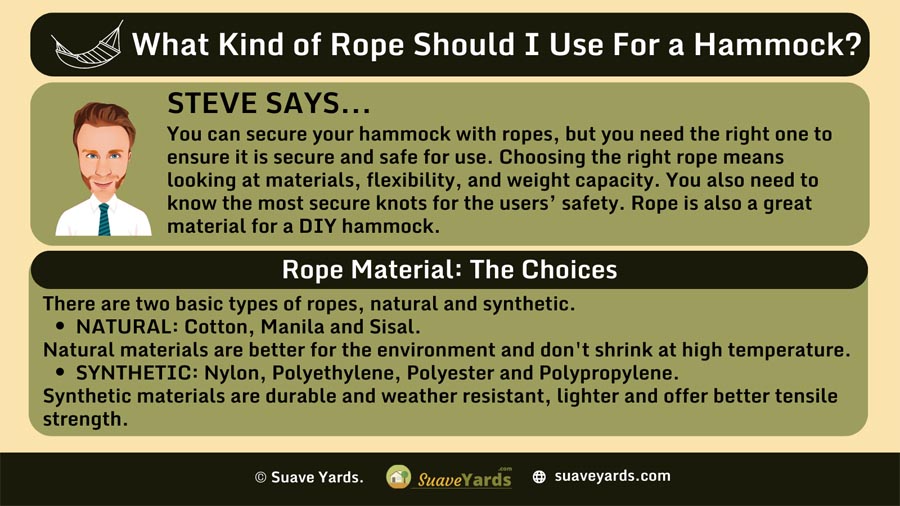
Most hammocks come with straps.
But for some, straps are considered accessories and have to be purchased separately.
That’s okay because you can use ropes to tie and secure the hammock.
You need the right ropes and knots to ensure the hammock is safe.
What is the appropriate rope for hanging a hammock?
Read on to find out.
You can secure your hammock with ropes, but you need the right one to ensure it is secure and safe for use. Choosing the right rope means looking at materials, flexibility, and weight capacity. You also need to know the most secure knots for the users’ safety. Rope is also a great material for a DIY hammock.
What Kind of Rope Should You Use for a Hammock?

Hammocks are for everybody, adults and children alike.
It is essential to keep the hammock secure to prevent accidents especially when wear and tear is heavy.
Check out the following criteria when looking for a rope to fasten your hammock properly:
1. Material
There are two basic types of ropes: natural and synthetic.
Either can be used for hanging a hammock, and each has its own strengths and weaknesses.
Natural
Ropes made of natural fibers normally use the following materials:
- Cotton
- Manila
- Sisal
These ropes are used for general purposes, including hammock ties.
They are preferred, generally, because of their natural properties, which are better for the environment.
They also don’t shrink at high temperatures.
When it comes to hammocks, though, natural ropes are better off as a material for the actual bed or fabric of the hammock rather than the fastener.
Synthetic
Most synthetic ropes are made of the following:
- Nylon
- Polyethylene
- Polyester
- Polypropylene
Synthetic materials, particularly nylons, are durable and weather-resistant, which are exactly the characteristics you need when looking to secure a hammock.
Further, synthetic ropes are resistant to abrasion and chemicals.
Their biggest advantage is strength.
Synthetic ropes are generally lighter than natural fibers but they offer better tensile strength, which refers to a product’s ability to withhold maximum weight or stress while being stretched.
That’s exactly what you need in ropes used to hang a hammock.
One of the disadvantages of synthetic rope is that it’s prone to shrinkage at high temperatures.
2. Thickness
How thick should your rope be?
On one hand, you want it to be as thick as possible to carry more weight.
On the other, a thick rope can be hard to tie into knots, which would properly secure a hammock.
Here’s something I learned from the online publication Hunker:
“There’s a rule of thumb you can rely on to tell if a rope is strong enough to hold a hammock. Multiply the diameter of the rope by itself, three times. Multiply the result by 2,000. The answer is the number of pounds a rope can support. If you do this for a one-inch rope, its safe working load is 2,000 pounds, more than enough to support any hammock. This means that any rope under one inch in diameter is suitable for hanging a hammock.”
But you don’t really need 2,000 pounds of weight in your hammock.
Most hammocks on the market have a weight capacity range of 200 to 800 pounds.
So, ropes with a diameter of AT LEAST 6 mm to 8 mm will do.
As a rule of thumb, go thicker if you are using natural fibers.
3. Flexibility
Strength is not enough when talking about ropes, especially those that will be used in hanging hammocks.
You need the rope to be flexible, which is its ability to remain intact despite bending.
A rope used for tying hammocks will have to endure multiple bends in the process.
Flexibility increases according to the number of strands of fabric used to create the rope.
For flexibility, look for a rope described as “soft laid” or “lang lay.”
Rope Vs. Straps

Should you use rope or straps to secure your hammock?
First, let’s check out what hammocking enthusiasts are saying about this issue on Reddit:
“Straps distribute the load across their width. This makes them less likely to harm bark. I camped around a lot of ponderosa pines and switched, my rope kept digging into the bark.”
“The main concern with hanging on trees is compressing the growth layers (cambium) of the tree. That layer is right below the bark and it can be damaged with compression so that nutrients are not flowing within the tree…effectively strangling it. Dead trees are no good for anyone, so using straps to distribute the load over a larger area, reducing and spreading out the compression forces on the tree.”
Many prefer using straps because they don’t want to damage trees.
Ropes, which are thinner than straps, would dig into the tree, scratching it and exposing it to pests and diseases that would sometimes lead to death.
The wound on the tree may also constrict its growth.
Here is a summary of why hammock straps are preferable:
- Straps are safer because they distribute the weight of the hammock over a wider area since they are generally wider than ropes.
- You don’t need to learn complicated knots to secure the hammock with straps.
- Straps are safer for trees.
- The straps that come with the hammock set are perfectly matched with the hammock, so you know it can support the fabric and its user properly.
In other words, use ropes only when hammock straps are not available e.g., you lost them or they got damaged.
The only advantage of using the rope is that it is readily available.
You can buy ropes in many stores, unlike hammock straps which are usually only available in outdoor or sporting goods stores.
Can You Make Your Own Hammock Using a Rope?
Yes, you can!
You can use rope as your main hammock bed and as your fastener.
For the hammock bed, use rope made of natural fiber because it is better for your skin.
It is inevitable that the hammock material will touch your skin.
Here are the steps to create a DIY hammock:
1. Prepare Your Materials
- Synthetic ropes of your choice to hang the hammock
- (10) ropes made from natural fiber (preferably cotton) for your hammock bed; they should be around 30 meters
- (2) metal rings
- (2) wooden dowels at one meter each
2. Attach the Natural Ropes to a Metal Ring
To make it simpler for you, hang the metal ring on a door knob or somewhere else that would be easier for you to make the DIY hammock.
Put a cotton rope through the metal ring and allow it to hang at equal length.
Secure the rope in a knot.
Repeat the steps on the nine other ropes.
3. Drill Holes Onto the Wooden Dowels
Since you have 10 ropes, drill 10 holes into each dowel and make sure they are evenly spaced.
4. Take the Ropes Through the Dowel Holes and Weave the Hammock Bed
Thread the rope through its respective hole.
Start weaving your ropes by first tying the first two ropes with a basic overhand knot some two inches below the wooden dowel.
Do the same with the other two ropes.
Repeat the process for the next row, but this time, tie the second rope with the third, the fourth with the fifth, and so on.
Notice that you are making diamond shapes all over the hammock to allow it to cradle a person.
5. Secure With the Next Dowel
Just eyeball the hammock and take note if you are near the end of the main hammock part.
If you are, add the second wooden dowel and put the ropes through the respective holes.
6. Secure the End Ropes Through the Other Metal Ring
Secure the ends of the ropes with a secure knot on the second metal ring.
7. Attach the Synthetic Ropes to the Trees or Poles
Now, take your synthetic ropes for hanging.
Find large and robust trees where you can hang your hammock.
Use secure knots to attach the hammock to a tree.
This is just a simple DIY hammock you can create using ropes. There are other techniques you can try too.
Final Thoughts

There is nothing like relaxing in a hammock.
It allows you to enjoy the sunlight on your skin while breathing in fresh air.
Or if you do it at night, you can enjoy the breeze while looking at the wonderful sky.
But make sure you have the hammocks secured properly with the right kind of rope.
